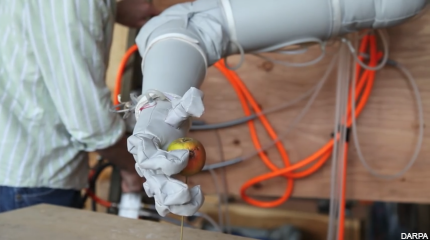DARPA-funded soft robotics program is a Big Hero
An inflatable robotic arm developed at Carnegie Mellon under DARPA’s M3 program served as the inspiration for Baymax in the hit movie.

An air-filled robotic arm served as the inspiration for Baymax.
Pentagon-funded research has produced technologies that have a big impact in the real-world lives of everyday people, from the Internet to the Global Positioning System. Now even fiction is following research facts.
The Defense Advanced Research Projects Agency is funding research into inflatable robotics that, it turns out, is the inspiration for a key character in the hit animated movie, “Big Hero 6.” Don Hall, who co-directed the movie, got the idea for Baymax, a big hearted inflatable robot, when he saw a soft, air-filled robotic arm while visiting Carnegie Mellon University's Robotics Institute several years ago.
DARPA supports Carnegie Mellon’s research—as well as research by iRobot and Otherlab—through its Maximum Mobility Manipulation, or M3, program. M3’s research into soft robotics aims to increase the mobility of robots while creating a framework for fast prototyping and production, including fabricating robotics with 3D printing.
Carnegie Mellon researchers are working to make a robot’s movements more human-like, incorporating technologies such as artificial muscles, touch sensors, stretchable films, flexible electronics and pressure-sensitive skins. When Hall saw the inflatable arm, the shape of Baymax was born.
"It really became apparent when we saw the soft robotics that that would be our ticket to putting a robot on the screen we had never seen before," Hall told Carnegie Mellon News.
Robots with greater flexibility could help in military operations, where level terrain and unobstructed areas are rare, whether as a fully intact robot or as, say, a strap-on arm with a pneumatically controlled hand that could extend the reach, strength or capability of what a person could do.
Carnegie Mellon researchers also said soft robotics could have medical uses—as prosthetics or as artificial skin, for example—and could assist in the care of the elderly or disabled. The arm Hall saw on his visit, developed by Siddharth Sanan during his Ph.D. thesis research, is capable of giving a sponge bath and maneuvering a spoon into a person’s mouth. Soft, inflatable robotics would be less likely to cause accidental injury, researchers said, and could be stored in small spaces and easily transported.
In addition to developing lightweight, flexible and relatively inexpensive robotics, the researchers said a big focus was on the usefulness of their developments. The research may have inspired a fanciful, lovable animated character (Rolling Stone called Baymax the “breakthrough star of the season”), but the real focus was on real-world uses.